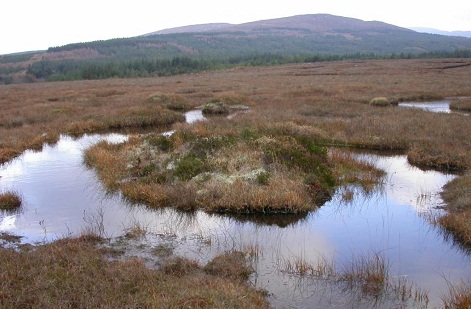
Cloghercor Bog near Glenties
At this time of year bogs can be as colourful as woodlands, especially those where grasses and sedges are dominant. Bog Cotton, Deer Sedge and Purple Moor Grass all play a big part in the picture, melting into a lovely blend of gold and orange and burnt umber. And although the flowering plants are mostly over, it’s worth getting in to have a close look at the bog surface with its sphagnum mosses and lichens, in all their rich variety of pinks and greens and greys.
Most of Ireland’s peatlands have been partly or largely cut over, but we still have some of the best examples of blanket bog in western Europe. Those that have managed to survive intact have a high value as wild habitats. Fine examples are the lowland blanket bogs of the Pettigo Plateau and Lough Barra below the Glendowan Mountains, and the mountain blanket bog on Slieve League. Sadly, one of very best, Gannivegil Bog between Doochary and Dungloe, was burnt in the early summer fires. Although it quickly coloured up again, it will be a long time before the plants and animals that were hardest hit will return to anything like their proper role in the wildlife web of the bog.
What lies under the living blanket of the bog is just as interesting as what’s on top. Peatlands have been forming from dead plant material for thousands of years, so when you see the cut-off edge of a bog, you’re looking at layer upon layer of history. Samples of pollen from different depths can tell us what the landscape was like at different times – the waves of different trees that moved in after the last Ice Age, and the beginnings of forest clearance and farming. Traces of volcanic ash from Iceland’s volcanoes can help to give a precise date to a particular layer.
Bogs have also yielded up some of our best archaeological treasures – items in iron and gold, wood and leather, stores of bog butter, and around a hundred human bodies. Traces of settlements and field patterns, and ancient trackways from up to 5500 years ago, have all come to light. The story of landscape, climate, people and plants is unfolding like a history book.
Red Grouse have always been the classic gamebird of moors and bogs – but their plummeting numbers in recent years have become a big concern. Their main problem is the decline in the great carpets of heather that used to cover the upland landscape, for Grouse depend on young heather shoots for the main part of their diet, and they use the older taller plants for shelter and nest sites. Overgrazing by sheep and uncontrolled burning have been steadily reducing heather cover, and big spreads of conifer plantation have fragmented their habitat. However, a recent survey of their population across Donegal has found that we still have significant numbers in some areas, so we need to make sure that these are well protected.
Irish Red Grouse are a subspecies of the Willow Grouse that lives in scrubby woodland on the edge of the Arctic tundra, right across Canada, Scandinavia and Russia, and which turns white in winter to match the snow. Our birds keep their mottled reddish plumage all year round, but still show a hint of their more northern origins by having feathered legs and feet which act as warm socks.
Hares can make a home for themselves in many different habitats, including wild peatlands. In the blanket bogs, they’re probably the mammal that you’re most likely to see. The Irish Hare has been around for a long time. A specimen found in Waterford has been dated to over 28,000 years old, making it one of our longest-established mammals. It’s a unique subspecies of the Mountain Hare which is found in northern parts of the world, and as in the case of the Grouse, while Mountain Hares generally go white in winter, our Irish Hare has largely lost the white coat habit. But if we continue to have long icy winters, it is likely that they too will develop their snow camouflage again – there were certainly more whitish Hares than usual during last winter’s big freeze.
Hares are superbly designed to alertness and fast escape. The big round eyes set in the sides of the head give them almost all-round vision, and the long hind legs give them their amazing speed and agility. They are expert at making sudden changes of direction to escape from predators. Unlike Rabbits, they live their lives entirely above ground. Young Hares are born open-eyed and fully furred, and sit motionless in their form, waiting for a feeding visit from their mother which usually happens at around dusk, just once a day. After a few days they start to move around a little, and are weaned at around three weeks. A female will generally produce two or three litters each year.
Four to Find this Month:Greenfinch: A beautiful olive-green Finch with bright yellow wing and tail markings. They are very regular visitors to peanut feeders, but people have been noticing dwindling numbers in recent years. |